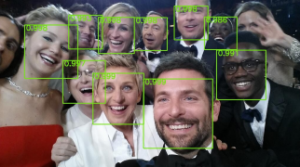Back in 2001, two computer scientists named Paul Viola and Michael Jones came up with a face detection algorithm called Detector Cascade. The algorithm was so simple and fast that it was built into many commercial products such as smartphones and digital cameras. We became very used to seeing that little box pop up around a person’s face when trying to take a picture.
However, there were some problems with the algorithm. It was 2001 after all.
The Detector Cascade could only detect a face if a person was facing the camera head-on. At any other angle, including upside down, we were out of luck.
That is, until recently.
Sachin Farfade and Mohammad Saberian at Yahoo Labs in California and Li-Jia Li at Stanford recently revealed a new model that can spot faces at any angle, even when partially occluded or upside down. The team utilized the high capacity of deep convolutional neural networks for feature extraction and trained the database in a single model called Deep Dense Face Detector by showing it 200,000 pictures of faces from different angles.
This is a huge step forward for image recognition, but unfortunately an added complication to our already increasing privacy concerns.
To learn more about the Deep Dense Face Detector, see their paper.










